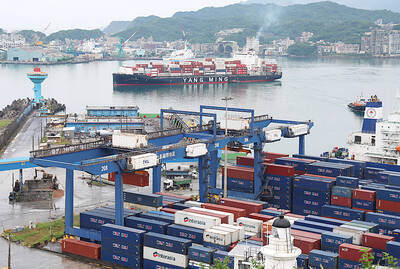Sharp Corp has agreed to sell three of its overseas factories to Foxconn Technology Group (富士康科技集團) for about ¥55 billion (US$667 million), Sankei newspaper said, citing unnamed sources.
The television assembly plants are located in Mexico, Malaysia and Nanjing, China, and sale procedures will start as early as this month, Sankei reported.
Sharp said last month there was “material doubt” about its ability to survive after forecasting a record ¥450 billion, full-year loss on falling demand for its display panels.
Sharp, the maker of Aquos televisions, is selling assets and seeking investment as it cuts salaries and jobs, and offers voluntary retirements as a part of a turnaround plan.
In July, Sharp sold a stake in an LCD factory in Sakai, central Japan, to Foxconn, who will jointly operate the 10th-generation facility, the industry’s most advanced.
Sharp’s talks with Foxconn over a capital tie-up may continue beyond a March deadline, Sharp said last month. Earlier this year, the two reached a preliminary agreement on Foxconn buying a 9.9 percent stake in the Japanese electronics maker for ¥550 a share, or ¥67 billion.
SHARES PLUMMET
Negotiations on a final price have yet to be completed as Sharp’s market value declined almost 75 percent this year, to close yesterday at ¥172 per share.
Sharp president Takashi Okuda said on Nov. 1 that the company is considering various partnership options. Kyodo News said on Nov. 13 that Sharp was in final talks with Intel Corp to receive an investment of as much as ¥40 billion, while the Wall Street Journal said on Tuesday that the company is in talks with Dell Inc to arrange a capital investment of US$240 million.
Sharp hemorrhaged ¥103 billion in cash from operations in the first half of the year. The company may turn to the Japanese government for a bailout, analysts said last month.

CHIP RACE: Three years of overbroad export controls drove foreign competitors to pursue their own AI chips, and ‘cost US taxpayers billions of dollars,’ Nvidia said China has figured out the US strategy for allowing it to buy Nvidia Corp’s H200s and is rejecting the artificial intelligence (AI) chip in favor of domestically developed semiconductors, White House AI adviser David Sacks said, citing news reports. US President Donald Trump on Monday said that he would allow shipments of Nvidia’s H200 chips to China, part of an administration effort backed by Sacks to challenge Chinese tech champions such as Huawei Technologies Co (華為) by bringing US competition to their home market. On Friday, Sacks signaled that he was uncertain about whether that approach would work. “They’re rejecting our chips,” Sacks

Taiwan’s exports soared 56 percent year-on-year to an all-time high of US$64.05 billion last month, propelled by surging global demand for artificial intelligence (AI), high-performance computing and cloud service infrastructure, the Ministry of Finance said yesterday. Department of Statistics Director-General Beatrice Tsai (蔡美娜) called the figure an unexpected upside surprise, citing a wave of technology orders from overseas customers alongside the usual year-end shopping season for technology products. Growth is likely to remain strong this month, she said, projecting a 40 percent to 45 percent expansion on an annual basis. The outperformance could prompt the Directorate-General of Budget, Accounting and

NATIONAL SECURITY: Intel’s testing of ACM tools despite US government control ‘highlights egregious gaps in US technology protection policies,’ a former official said Chipmaker Intel Corp has tested chipmaking tools this year from a toolmaker with deep roots in China and two overseas units that were targeted by US sanctions, according to two sources with direct knowledge of the matter. Intel, which fended off calls for its CEO’s resignation from US President Donald Trump in August over his alleged ties to China, got the tools from ACM Research Inc, a Fremont, California-based producer of chipmaking equipment. Two of ACM’s units, based in Shanghai and South Korea, were among a number of firms barred last year from receiving US technology over claims they have

BARRIERS: Gudeng’s chairman said it was unlikely that the US could replicate Taiwan’s science parks in Arizona, given its strict immigration policies and cultural differences Gudeng Precision Industrial Co (家登), which supplies wafer pods to the world’s major semiconductor firms, yesterday said it is in no rush to set up production in the US due to high costs. The company supplies its customers through a warehouse in Arizona jointly operated by TSS Holdings Ltd (德鑫控股), a joint holding of Gudeng and 17 Taiwanese firms in the semiconductor supply chain, including specialty plastic compounds producer Nytex Composites Co (耐特) and automated material handling system supplier Symtek Automation Asia Co (迅得). While the company has long been exploring the feasibility of setting up production in the US to address